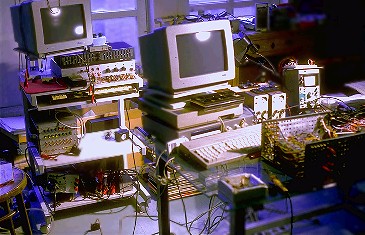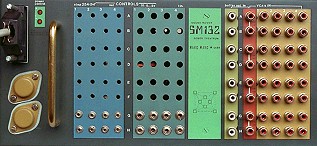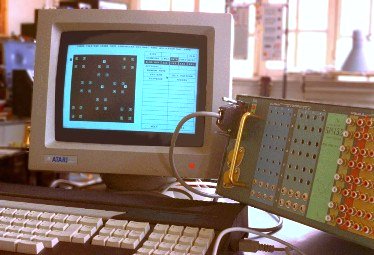Marc MarcSound Mover SM 132
|
test & modify setup |  | test & modify setup |

Some
Amsterdam, Rotterdam, IJmuiden, Holland, The Netherlands, Germany Berlin, Rimbaud, Art, Kunst |
FlexibilityWhen a sound needs to be moved over a set of 32 loudspeakers, this requires also 32 power amplifiers (or 16 stereo ones). When, in 1988, the Sonore Theatrum project was launched in Amsterdam - The Milkyway (by Willem de Ridder & Radio Rabotnik TV) we had 32 stereo amplifiers and 64 loudspeakers. But, a set like this is an enormous ballast in both size and weight. For most projects a set of 16 loudspeakers is enough. In combination with the SM132 this 'minimized' setup becomes very flexible. It is possible to let two sound sources move over the 16 loudspeakers (2x16=32) or to let 4 sound sources move over 2x8 channels (4x8=32) or to let 8 sound source move over 4x4 channels (8x4=32). because all VCA's are individual to patch it is also possible to use them for the master volume of each sound before it is balanced over the multi channel setup with the others. Each VCA that will be used for another purpose can not be used anymore for the moving (make sense). But, in many situations there is no need to use the full capacity of 32 channels and thus the 'unused' VCA's can be used for mastering. This give the advantage that the computer can keep sending the full dynamic range of the volume data while the mastering takes care about the actual volume of the sound sources. it all becomes a matter of making the right patch on the SM132 panel and adapting this information into the software.
The reason that the mutipliers are analog and not digital lays in the fact that with digital multipliers chips it is (at the time) very hard to make a silent system. With the commercial digital multipliers it even is impossible to prevent that the controlling data (2000 bytes per seconds) does not feed through into the audio signal. By using the 'old' analog principles it is possible to make a silent system with very good specifications. With the analog technique other problems occur but they can be solved by having the knowledge about this technique in contrast to the digital technique where the money becomes a significant factor).
The SM132 served me through the years very well with my sonic projects. It never fails, is insensitive to garbage on the outlet lines, does not heat up and can work 24 hours a day. Its a good horse.
The computer that I use to control the moving sound system is, still after all these years, the Atari ST. In contrast to the IBM compatibles running under Windows or Dos, the Atari does not crash at the wrong moment. Its system is relatively simple and more integer. The 8 Mega Hertz clock is due to the 68000 architecture of the ST fast enough (you would be surprised). The reason that I'm telling this is because of the fact that in my projects it is very important that the whole setup is extremely stable. The installation and all the sound devices, must be switched on with a single power switch and then start up automatically and do the job for many hours a day for many weeks without any experts being around. This excludes any commercial IBM machine and definitely the up to date machines that are running too much on high heels with the hardware. Secondly, the todays operating systems are too complex (and the writers of them are suffering on the disease of Alzenheimer) to guarantee a full proof operation over the required period. My goody old Atari ST beats them all when it comes to safety. |
|
Also view the GEAR catalog which contains many informative chapters on analog musical devices and fundamental issues on electronic music. For response see This page and all contents: (C)1996 by Marc Marc Amsterdam All technical pages are using a STYLE SHEET to set the font style. Please make sure that you have the option Style Sheet and Java Script are set enable. |
